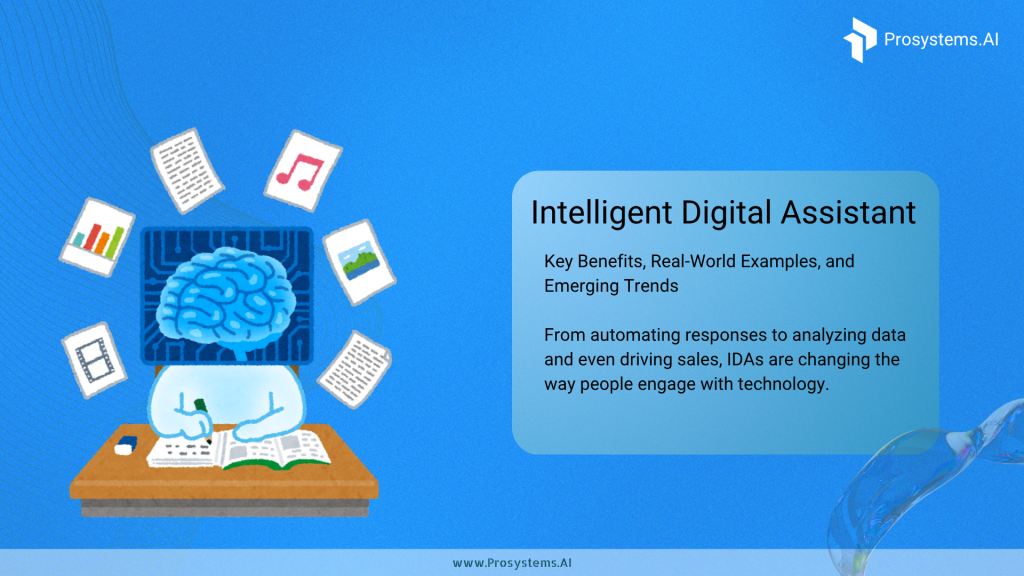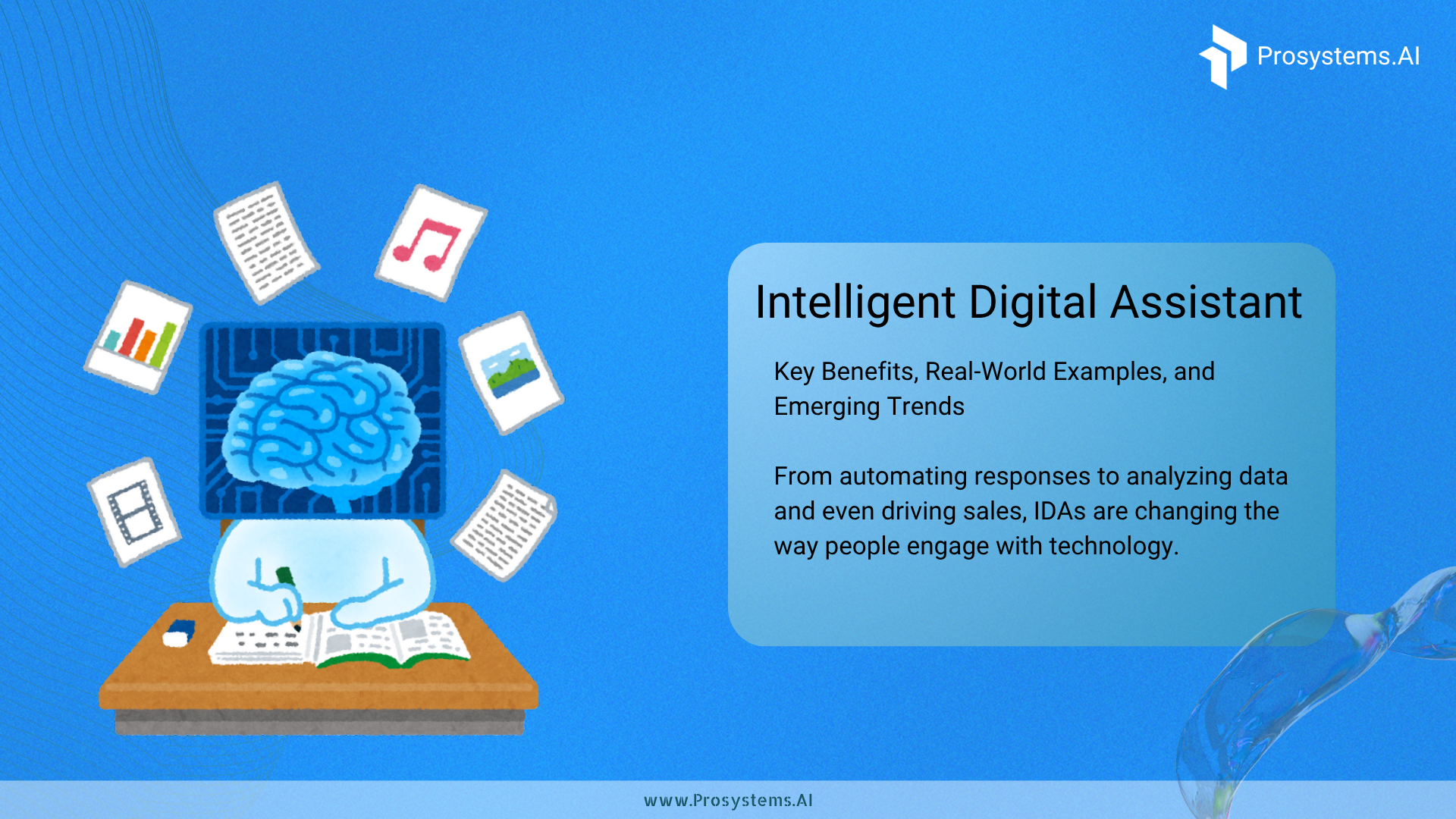
Intelligent Digital Assistants (IDAs) have quickly moved from novelty to necessity. Whether it’s asking Alexa to play your favorite song, having ChatGPT draft an email, or using a voice assistant to schedule a meeting, these tools are becoming part of our daily routines.
In personal life, they simplify tasks and provide real-time support. In business, they’re transforming customer interactions, boosting efficiency, and enabling smarter decision-making.
From automating responses to analyzing data and even driving sales, IDAs are changing the way people engage with technology.
In this article, we will explore how the capabilities of IDAs are growing, the rising expectations for more intuitive, responsive, and personalized digital experiences, and why embracing IDAs is becoming a critical competitive advantage for both individuals and businesses.
What is an Intelligent Digital Assistant
An Intelligent Digital Assistant (IDA) is a smart, AI-driven tool designed to interact with users in a conversational way, helping them complete tasks, find information, and improve productivity.
Unlike traditional virtual assistants, IDAs leverage artificial intelligence, natural language understanding, and real-time learning to interpret user requests, adapt to preferences, and deliver more relevant, personalized support.
They can manage everything from booking meetings and answering questions to assisting with complex business operations.
Found in smartphones, websites, enterprise software, and smart devices, IDAs are changing how we work and live by making interactions with technology more intuitive, efficient, and human-like.
Are Intelligent Digital Assistants Different from AI Assistants?
While the phrases “AI assistant” and “Intelligent Digital Assistant (IDA)” are often used interchangeably, there is a meaningful distinction between the two.
An AI assistant refers to any technology powered by artificial intelligence that performs tasks or provides support—whether it’s a chatbot answering basic questions or a smart system processing data behind the scenes.
It’s a broad term that covers a wide spectrum of AI-driven tools, ranging from simple automation to advanced decision-making systems.
In contrast, an Intelligent Digital Assistant is a more advanced and interactive form of AI assistant. IDAs are specifically designed to engage with users in a human-like way, often through voice or text, while understanding context, preferences, and intent.
These assistants go beyond basic responses by learning from user behavior and offering tailored suggestions or reminders without being prompted.
Think of it this way:
- An AI assistant might wait for your command.
- An IDA anticipates what you need—before you even ask.
IDAs blend technologies like natural language processing, machine learning, and real-time data analysis to deliver smarter, more personal interactions.
Their goal isn’t just to assist, but to actively enhance everyday workflows, customer service, and even decision-making.
In summary, AI assistants provide support, while Intelligent Digital Assistants provide smart, proactive experiences—bridging the gap between automation and truly intuitive interaction.
Core Technologies Behind Intelligent Digital Assistants
Intelligent Digital Assistants (IDAs) are becoming everyday problem-solvers—thanks to a sophisticated blend of modern technologies.
Here’s a look at the essential systems that make these assistants smart, responsive, and useful in both personal and business settings.
1. Natural Language Processing (NLP)
NLP is the engine behind an assistant’s ability to understand and interact using human language. It helps IDAs interpret voice and text commands, understand context, detect intent, and respond in ways that feel natural and conversational.
2. Machine Learning (ML)
Machine learning enables digital assistants to get smarter with every interaction. By learning from user behavior and feedback, ML allows IDAs to fine-tune their responses, anticipate needs, and offer more personalized experiences over time.
3. Voice Recognition and Text-to-Speech (TTS)
With voice recognition, IDAs can listen to spoken input and turn it into actionable data. Text-to-speech technology, on the other hand, gives them the ability to speak back to users in a human-like voice—creating seamless voice-first experiences.
4. Contextual Intelligence
Modern assistants don’t just respond—they understand. Contextual intelligence lets them analyze factors like time, location, user history, and device usage to deliver more relevant and timely support, improving both accuracy and user satisfaction.
5. Cloud-Based Infrastructure
Cloud computing empowers IDAs to process large volumes of data quickly and securely. It enables real-time access to tools, updates, and integrations—making these assistants scalable, efficient, and highly available.
6. API & System Integrations
To truly be useful, digital assistants need to connect with apps and tools people already use. Through API integrations, IDAs can sync with calendars, CRMs, email platforms, smart home devices, and more—allowing them to take action across different systems.
The Top Advantages of Intelligent Digital Assistants for Individuals and Businesses
Intelligent Digital Assistants (IDAs) are changing the way we interact with technology—both in our personal routines and in the workplace.
By combining natural language processing, machine learning, and automation, these AI-powered tools bring significant value to everyday life and business operations. Let’s explore how.
Benefits for Individuals
1. Freeing Up Time Through Automation
From sending quick reminders to booking appointments, IDAs take on repetitive daily tasks, helping users save valuable time and stay organized.
2. Always-On Assistance
Whether it’s early morning or late at night, IDAs are available 24/7—ready to answer questions, provide directions, or control smart home devices without delay.
3. Tailored User Experience
By analyzing usage patterns and preferences, digital assistants personalize suggestions—like curating playlists, offering relevant news, or optimizing daily routines.
4. Accessibility and Ease of Use
Voice-based commands and hands-free functionality empower users with limited mobility or visual impairments to interact with digital tools more easily.
5. Smarter Daily Decisions
From tracking health metrics to helping manage budgets, IDAs turn raw data into useful insights that support more informed personal choices.
Benefits for Businesses
1. Improved Customer Support
With AI assistants managing customer queries, businesses can deliver instant, accurate responses—enhancing the user experience without increasing staff workloads.
2. Streamlined Operations
Routine admin tasks like scheduling meetings, compiling reports, or updating records can be handled efficiently by IDAs, allowing teams to focus on strategic priorities.
3. Boost in Employee Efficiency
Digital assistants help employees stay on track with reminders, to-do lists, and quick access to information—minimizing distractions and boosting productivity.
4. Scalable Customer Interaction
As demand grows, businesses can rely on IDAs to manage high volumes of customer interactions without sacrificing service quality or needing additional resources.
5. Insightful Analytics
By gathering and analyzing real-time data, IDAs help businesses identify trends, monitor performance, and make smarter, data-backed decisions.
How Intelligent Digital Assistants Are Transforming Industries
Intelligent Digital Assistants (IDAs) are rapidly becoming essential tools across a wide range of industries.
By automating routine tasks and enhancing user interactions, they’re helping organizations improve productivity, customer experience, and decision-making. Here’s how they’re making an impact in key sectors:
Healthcare: Smarter, More Accessible Care
- Easy Scheduling: Patients can book, adjust, or cancel appointments through voice or chat without ever calling a clinic.
- Health Reminders: Assistants send timely alerts for medications and upcoming appointments, encouraging better adherence.
- Initial Triage Support: AI-powered assistants gather symptoms and suggest next steps, helping route patients efficiently to the right care.
Finance: Making Banking Seamless
- Everyday Transactions: From checking account balances to paying bills, IDAs offer 24/7 self-service options.
- Security Alerts: Assistants notify users of suspicious activity instantly and help them take protective action quickly.
E-Commerce: Personalized Shopping at Scale
- Order Updates: Customers can ask about delivery status, returns, or previous orders—getting instant answers without navigating complex menus.
- Tailored Suggestions: By analyzing customer behavior, IDAs recommend products users are more likely to buy, boosting engagement and sales.
Customer Service: Instant Support, Human Feel
- Fast Responses to FAQs: Virtual agents handle high volumes of common questions efficiently, providing consistent and quick replies.
- Smooth Agent Handoff: When needed, IDAs pass customers to human support without losing context, making transitions seamless.
Enterprise Operations: Simplifying the Workday
- Smart Scheduling: IDAs coordinate meetings, check availability, and send reminders, minimizing back-and-forth emails.
- Automated Data Management: Tasks like logging customer info or updating reports are handled in the background, saving valuable time.
- Real-Time Reporting: Need insights fast? Assistants can pull and deliver reports instantly—no analyst required.
The future of intelligent digital assistants (IDAs)
The next generation of intelligent digital assistants (IDAs) will go far beyond managing basic tasks—they’ll become deeply integrated partners in our everyday lives and workplaces.
With rapid improvements in AI technologies like contextual learning and conversational understanding, these assistants will be able to anticipate user needs, offer tailored recommendations, and act proactively across multiple devices.
In professional settings, they’ll help optimize workflows and support decision-making. In personal life, they’ll handle daily routines with minimal input. As their capabilities continue to expand, IDAs are set to become essential, always-on collaborators that adapt to us in real time.
Q&As
1. Q: What powers Intelligent Digital Assistants behind the scenes?
A: Intelligent Digital Assistants operate using a combination of technologies like natural language processing (NLP), machine learning, and speech recognition. These tools enable them to understand commands, interpret context, and deliver smart, real-time responses.
2. Q: Are Intelligent Digital Assistants just advanced chatbots?
A: Not quite. While they share similarities, IDAs are far more sophisticated. Unlike standard chatbots, they can handle complex tasks, offer tailored responses, and integrate with various apps and systems to deliver a more seamless user experience.
3. Q: How secure are Intelligent Digital Assistants?
A: Most high-quality IDAs come with strong privacy safeguards. However, it’s crucial for users and businesses to evaluate the assistant’s security features and ensure data is managed responsibly according to their needs.
4. Q: Do Intelligent Digital Assistants work offline?
A: Typically no. Since IDAs rely heavily on cloud computing and real-time data processing, they require an internet connection to function effectively and deliver accurate outputs.
5. Q: Can Intelligent Digital Assistants adapt to user habits over time?
A: Yes, many modern IDAs are built with adaptive learning capabilities. They observe usage patterns and preferences, allowing them to deliver more customized interactions as they get to know the user better.
6. Q: Will Intelligent Digital Assistants replace human workers?
A: Rather than replacing humans, IDAs are designed to support them by automating repetitive or time-consuming tasks. This allows professionals to focus more on creative thinking, decision-making, and building relationships.

Leave a Reply